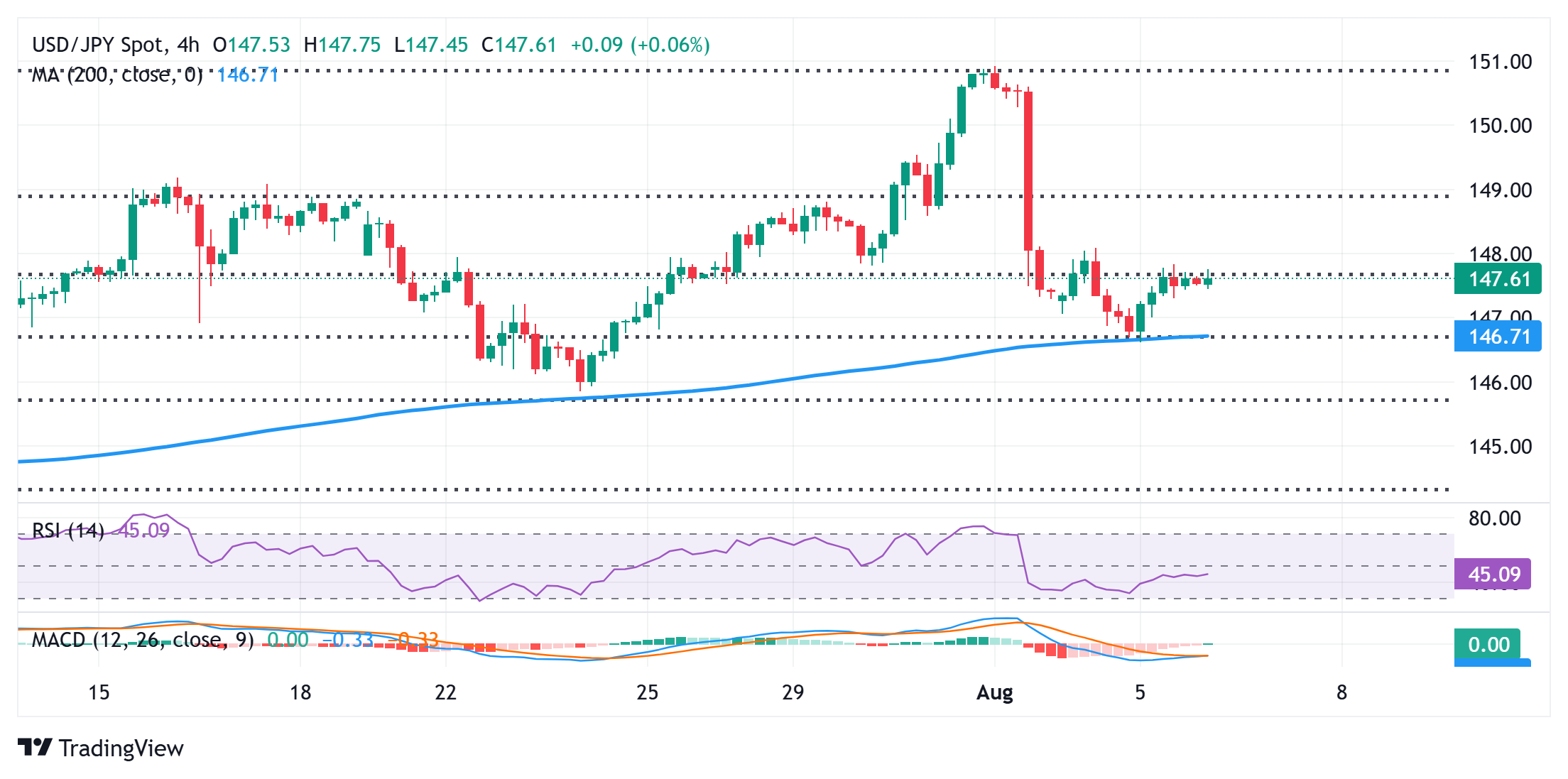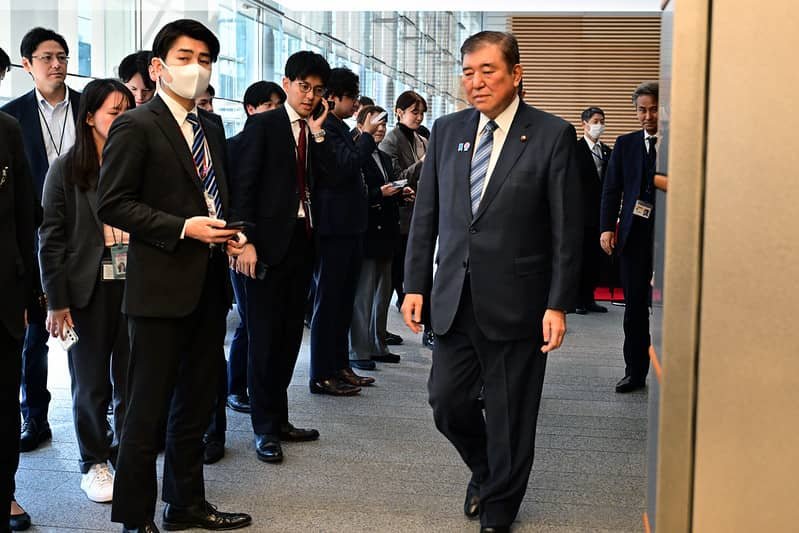- The Japanese Yen attracts some dip-buying, though it lacks bullish conviction.
- Weak real wages data from Japan tempers BoJ rate hike bets and caps the JPY.
- Rising September Fed rate cut bets weigh on the USD and the USD/JPY pair.
The Japanese Yen (JPY) edges higher against its American counterpart during the Asian session on Wednesday and stalls the previous day’s sharp retracement slide from a nearly two-week top. The growing acceptance that the Bank of Japan (BoJ) will hike interest rates by the end of this year turns out to be a key factor acting as a tailwind for the JPY. However, expectations that prospects for BoJ rate hikes could be delayed for a bit longer might hold back the JPY bulls from placing aggressive bets.
Data released earlier today showed that inflation-adjusted real wages in Japan fell for the sixth straight month in June and fueled concerns about a consumption-led recovery. This comes on top of domestic political uncertainty and could complicate the BoJ’s policy normalization path. Apart from this, a positive tone around the equity markets contributes to capping the safe-haven JPY. The US Dollar (USD), on the other hand, struggles to lure buyers amid bets that the Federal Reserve (Fed) will resume its rate-cutting cycle in September, which, in turn, is seen acting as a headwind for the USD/JPY pair.
Japanese Yen lacks bullish conviction as positive risk tone offsets BoJ rate hike bets
- Government data released earlier this Wednesday showed that nominal wages in Japan rose 2.5% YoY in June, the fastest pace in four months, though it was below market expectations. Adding to this, inflation-adjusted real wages declined 1.3% from a year earlier, following a revised 2.6% drop in May.
- Meanwhile, the consumer inflation rate the ministry uses to calculate real wages – which includes fresh food prices but not rent costs – rose 3.8% YoY in June, the lowest in seven months. Wage trend and inflation are among the key factors the Bank of Japan monitors to determine the timing of the next rate hike.
- The data, however, highlights broader pressures on consumption. Furthermore, the ruling Liberal Democratic Party’s loss in the July 20 polls raised concerns about Japan’s fiscal health amid opposition calls to boost spending and cut taxes. This suggests that prospects for BoJ rate hikes could be delayed further.
- Moreover, BoJ Governor Kazuo Ueda last week signaled continued policy patience. That said, the BoJ has repeatedly said that it will hike interest rates further if growth and inflation continue to advance in line with its estimates. The mixed cues, in turn, do little to provide any impetus to the Japanese Yen.
- The US Dollar attracts some buyers following the previous day’s two-way price moves and acts as a tailwind for the USD/JPY pair during the Asian session on Wednesday. The USD bulls, however, lack conviction amid the growing acceptance that the Federal Reserve will cut interest rates in September.
- The bets were reaffirmed by the disappointing US release of the US ISM PMI, which unexpectedly fell to 50.1 in July from 50.8 in the previous month. This comes on top of weaker-than-expected US Nonfarm Payrolls last Friday and fueled worries about the economic health, which could cap the USD.
- Separately, the US Census Bureau and Bureau of Economic Analysis reported that the trade deficit narrowed more than expected, to $60.2 billion in June from $71.7 billion in the previous month. This reflects a dip in imports at the end of the second quarter following a tariff-fueled spike earlier in the year.
- In the absence of any relevant market-moving US macro data, speeches from FOMC members could influence the USD later during the North American session on Wednesday. Apart from this, the broader risk sentiment will drive the safe-haven JPY and provide some impetus to the USD/JPY pair.
USD/JPY needs to find acceptance below 50% Fibo. to back the case for further losses

The overnight resilience below the 50% retracement level of the rally from the July swing low and the subsequent recovery favors the USD/JPY bulls. Moreover, oscillators on the daily chart have again started gaining positive traction and back the case for additional gains. That said, any further move up beyond the 147.75 area, or the 38.2% Fibonacci retracement level, might confront some hurdle near the 148.00 round figure. A sustained move beyond the latter will suggest that spot prices have formed a near-term bottom and pave the way for further strength towards the 148.45-148.50 intermediate hurdle en route to the 149.00 neighborhood, or the 23.6% Fibo. retracement level.
On the flip side, the Asian session low, around the 147.45 region, now seems to act as an immediate support for the USD/JPY pair. Any further downfall could be seen as a buying opportunity near the 147.00 round figure. However, some follow-through selling below the 50% retracement level, around the 146.85 area, which coincides with the 200-period Simple Moving Average (SMA) on the 4-hour chart, could make spot prices vulnerable to accelerate the fall towards the 146.00 round figure. The downward trajectory could extend further and eventually drag spot prices to the 61.8% Fibo. retracement level, around the 145.85 area, en route to the 145.00 psychological mark.
Japanese Yen FAQs
The Japanese Yen (JPY) is one of the world’s most traded currencies. Its value is broadly determined by the performance of the Japanese economy, but more specifically by the Bank of Japan’s policy, the differential between Japanese and US bond yields, or risk sentiment among traders, among other factors.
One of the Bank of Japan’s mandates is currency control, so its moves are key for the Yen. The BoJ has directly intervened in currency markets sometimes, generally to lower the value of the Yen, although it refrains from doing it often due to political concerns of its main trading partners. The BoJ ultra-loose monetary policy between 2013 and 2024 caused the Yen to depreciate against its main currency peers due to an increasing policy divergence between the Bank of Japan and other main central banks. More recently, the gradually unwinding of this ultra-loose policy has given some support to the Yen.
Over the last decade, the BoJ’s stance of sticking to ultra-loose monetary policy has led to a widening policy divergence with other central banks, particularly with the US Federal Reserve. This supported a widening of the differential between the 10-year US and Japanese bonds, which favored the US Dollar against the Japanese Yen. The BoJ decision in 2024 to gradually abandon the ultra-loose policy, coupled with interest-rate cuts in other major central banks, is narrowing this differential.
The Japanese Yen is often seen as a safe-haven investment. This means that in times of market stress, investors are more likely to put their money in the Japanese currency due to its supposed reliability and stability. Turbulent times are likely to strengthen the Yen’s value against other currencies seen as more risky to invest in.







